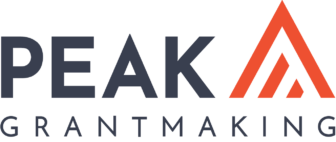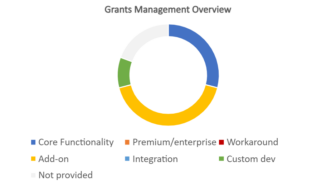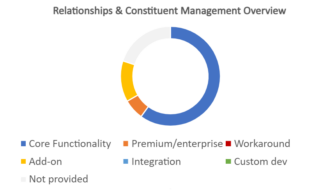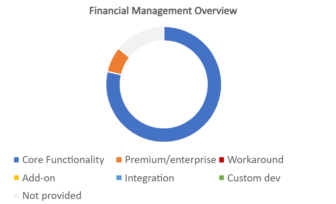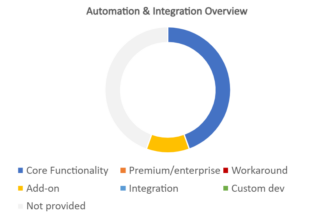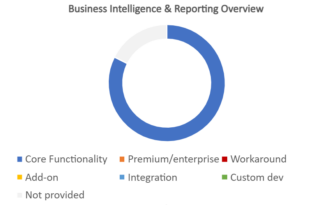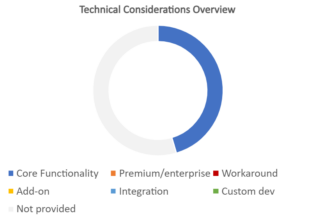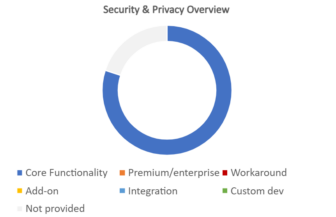Foundation Source is a foundation management and services company that works with family, corporate, and professionally staffed foundations. Its Impactfully platform is the newest iteration of the Foundation Source Online technology product that served as the backend platform used by Foundation Source’s services team and a frontend portal for its clients. The latest version of the software gives clients access to the full capabilities of the platform and provides grants management and expense management functionality paired with a proprietary database of nonprofits that brings together IRS data and their own staff research to provide a comprehensive listing of nonprofit profiles.
This database means that organization records are handled slightly differently than in other systems. Rather than creating organization records, applications and grants are instead appended to existing organization records in the database. Organizations not in the database go through a certification process by Foundation Source staff before being entered.
The software provides some additional features around granting, including an approach that facilitates discretionary grants made by board members and staff members. Because Foundation Source is also a professional services company, it can also execute grant and expense payments, including conducting due diligence, compliance verification, monitoring for fraud, and distributing award notification letters
Vendor: Foundation Source
Year Released: 2023
Pricing
Pricing is based on a combination of flat fees and services. The vendor offers four packages that range from the Independent package—which is fully managed by your foundation—to the Inclusive package, which includes Foundation Source administrative services and automated reporting feeds from your financial institution. The online applications and outcomes module is included with the Independent and Essential packages but is an add-on at an additional cost for the Collaboration and Inclusive packages. Implementation is priced separately from the yearly subscription fee and ranges from free to $10,000.
Estimated Yearly Costs:
- Small Foundation (< $25 million in grants, 1-5 staff): $10,000-$24,000
- Mid-Size Foundation ($25-500 million in grants, 10-25 staff): $10,000-$88,000
- Large Foundation (> $500 million in grants, 50+ staff): $10,000-$120,000
Grants Management
Grant records in the system can either be based on application records that have been approved for grants or as standalone grants without an accompanying application history. They are connected to an organization record in the database and include related attachments, interactions, contacts, notes, grant payments, and any outcomes collected through grantee reporting. There are also a variety of custom fields at the bottom of the record that are configurable to collect many different types of information. The custom fields can pull data from forms that you want to show on the record, like demographic data. Custom fields are also used for internal users to fill out as part of the workflow. The database is automatically updated when the IRS releases business master file updates. This is in addition to the database manual compliance checks conducted by Foundation Source staff on charities not in the IRS database. OFAC compliance checks are automatically run prior to grant and expense payments.
The ability to collect online applications is included in some packages and sold as an add-on for others. The system provides a wizard that walks you through the steps of creating an application, including putting together a customizable welcome page that can be branded with your logo, an eligibility quiz that can branch to multiple forms if needed, and the application form itself. Application forms can contain a variety of field types but are not able to accommodate questions with branching logic. The system permits file attachments up to 100MB, but the foundation can set limits on the max file size for uploads; there are no limits on the number of file uploads or on the amount of file storage. Foundations can duplicate or clone past applications to create new ones, but applicants cannot. Foundations can share links to applications publicly or invite nonprofits to apply privately. Applications can be used for both organizational and individual grants.
You can separate applications into sections with navigation tabs on the side of the form. Information entered by the applicant autosaves as they move between fields, and a “save draft” button allows them to save their work and receive an email with a direct link to the application as well as a PDF copy of what they have filled out thus far. At this time, you cannot prepopulate application fields with information from the registration process or the database, but the vendor says that this is on the roadmap for later this year. Foundation users can go into the application and fill it out on behalf of a charity.
GivingHub, the Foundation Source applicant and grantee portal, included in the Independent and Essentials packages and available as an add-on purchase for the Collaboration and Inclusive packages. The portal isn’t specific to the foundation, but instead includes any of the user’s applications and grants from any foundation that uses Impactfully. As such, it is branded as GivingHub by Foundation Source and does not include foundation branding. Users can see applications they’ve been invited to complete, those that are in progress, and any that have been submitted, as well as grants that have been approved along with payment information. They can also submit and see outcomes reports.
Applicants can create a profile in GivingHub and associate that profile with a nonprofit from Foundation Source’s database. If their organization is not listed in the database, they can create a new record and submit an application but the application would show up as on hold until it’s vetted by Foundation Source’s research team. Applicants can invite others to collaborate on applications . These collaborators can be in their organizations or from other organizations. However, there is no way to limit their ability to see other applications or grants in the applicant’s account.
Reviewers can access the applications assigned to them directly through the Impactfully platform; there is no external reviewer portal. Permissions limit what they are able to see in the platform. You can assign applications to reviewers individually or to a committee composed of multiple reviewers. You can have a variety of different scoring schemes for applications, with numeric scores, radio buttons, dropdown lists, and text entry and you can use the reporting tools in the system to see a summary of review scores.
Relationships and Constituent Management
Organization records already exist in the system within the database of nonprofits curated by Foundation Source. The vendor receives a monthly feed of data from the IRS business master file, and also has a charity research team that looks into nonprofits not in the IRS file or whose records are on hold. Verified nonprofits are tagged with an icon. Each organization record also has a link to the nonprofit’s page on Candid’s GuideStar. The links pop open to the organization’s page on the Candid website, and the information on the GuideStar profile has to manually be added to the system. Individual contact records can be created and associated with the organization records. You can also mark organization records as favorites so that they show up at the top of search results.
The system supports emails and letters that can be created using a WYSIWYG editor, as well as custom templates. These templates can pull in information from the system and can be customized before sending. You can send emails to individuals but the ability to send bulk emails requires the Applications and Outcomes module; bulk email sends do not include data about opens or clicks. All emails sent through the system are saved to the grant application or organization record. Emails sent outside the system have to be entered as a note.
The system includes a document library that allows users to create folders and add files for other users to access. This is where foundations can save board meeting documents and determination letters. There is no board portal functionality but you can create accounts for board members to log in and view dashboards and documents or review and vote on grants.
Financial Management
The system includes flexible payment functionality. A grant wizard in the system walks you through setting up payments and associating those payments with budgets in the system. You can set up default payment schedules for grants and you can also change individual payment dates and budgets as needed. These payments can be multi-year as well. A subscription package includes the option of letting the vendor take care of check disbursements for you, and the vendor reports that it is currently working on the ability to make digital payments via PayPal as well.
Budgets are created in their impact plan functionality. When you create an impact plan, you associate a budget with it and you can use the impact plan tool as a dashboard to view budget drawdowns and a list of individual grants related to that budget that you can click into. The system will also notify you if a planned payment will exceed the budget set up in the system. “What if” functionality and forecasting can be done by running reports on future grants. The system does not include an accounting tool, but a pre-built integration allows you to export files to QuickBooks.
Automation and Integration
Workflows in the system are focused on the application and review process. Submitted applications have a status of “under review,” and there are four preset system statuses: voting required, voting complete, enter grant, and decline application. You can also use tags to highlight or hide fields from reviewers and other users to control who sees certain information at different steps in the workflow process. Custom grant and expense approval flows that provide financial controls are also available.
The system allows for automated emails for reminders and confirmations. You can perform batch updates on groups of records for certain actions. The vendor can provide a template for new clients to upload grant history, but other batch updates via file upload require an additional services agreement. There is a public REST API that exposes some endpoints publicly so any browser can call them. Pre-existing integrations allow you to export records to QuickBooks and access nonprofit profiles on Candid GuideStar.
Business Intelligence and Reporting
The search bar at the top of the welcome page in the system has two tabs: one allows you to search for organization records and the other for grant records. The organization search prioritizes your favorites and results with which you have had previous interactions. You can get matches from partial word searches, but it is not a fuzzy search.
Dashboards contain shortcut tiles that display a user’s frequently accessed actions. Users can customize their dashboards by organizing or adding tiles. Tiles include personal and foundation task lists, quick report charts, and automated tracking of the foundation’s remaining annual 5 percent minimum distribution requirement. The tiles a user can view are governed by system permissions. Administrators can customize dashboard views for other users, such as external reviewers and board members.
The system includes 38 prepackaged reports. These standard reports can be edited and saved as custom reports. You can mark reports as favorites. The system also allows you to create a variety of ad hoc reports. Reports can be exported in a variety of formats. You can also schedule reports to run at specific times and these can be emailed to users. Outcome reports can be created based on data collected from grantees; outcome report requests are associated with payments. You also can create outcomes on behalf of grantees so that the foundation can submit the necessary information.
Technical Considerations
The system has some responsive design features, and the vendor also offers a mobile app for optimized display on non-desktop devices. The app lets you perform nearly all actions in the system except for configuration. The system is not WCAG 2.1 compliant, but the vendor reports that it is working on accessibility features. There is no pre-loaded common taxonomy in the system, but clients can define their own tags and categories in the system. Grants and payments can be tagged with an impact plan or a report code, which allows for categorization and reporting. The system does not provide multi-currency or multilingual support.
New clients can use the system’s tool to import their grant history. The vendor provides a CSV template that foundations can use with their past grant data. When you upload the spreadsheet into the system, it will guide you through a wizard that helps you match the grant to charity records in the database and prompts you for any data that needs to be clarified or fixed.
Security and Privacy
Login security is protected by multi-factor authentication. There is no single sign-on ability but this is on the vendor roadmap. Granular permissions govern what individuals can see and do in the system. Data is encrypted at rest and in transit, and the vendor reports the platform is SOC2 compliant. An audit log records all system actions. The vendor provides links to security and privacy policies to clients, but they are located behind a login page.
Training and Support
|
|
Included | Additional Cost |
Not available |
|
Phone |
X |
||
|
Chat |
X |
||
|
|
X |
|
|
|
Knowledgebase |
X |
|
|
|
Training Videos |
X |
||
|
User Community |
X |
||
|
Implementation |
X |
The vendor provides phone and email support to clients, either by appointment or 9 a.m. to 5 p.m. in their respective time zones. Email support is free for all clients, and phone support comes with all packages except Independent. There are also a variety of in-system help and tool tips available and marked by icons—a triangle with an exclamation point or a small “i”—that users can hover over for explanations or pointers. There are also help videos that pop up for some functions, and sections for users to provide feedback. The vendor releases updates every two weeks. Technical support is also available for applicants using the Foundation Source GivingHub applicant portal, with a link to a help page at the bottom of the screen where people can search for help topics or submit a request for support.
The vendor’s Resource Hub includes a variety of articles, videos, webinars, demos, and more that you can search and filter by topic, user role, or resource type. There is no online user community. System implementation is priced separately from the yearly subscription fee and the vendor provides unlimited and complimentary technical training. The vendor has a Philanthropic Advisory group that can additionally provide small group and customized training for a fee.
Customer Experience Survey
Number Of Survey Respondents Using The System: 0

